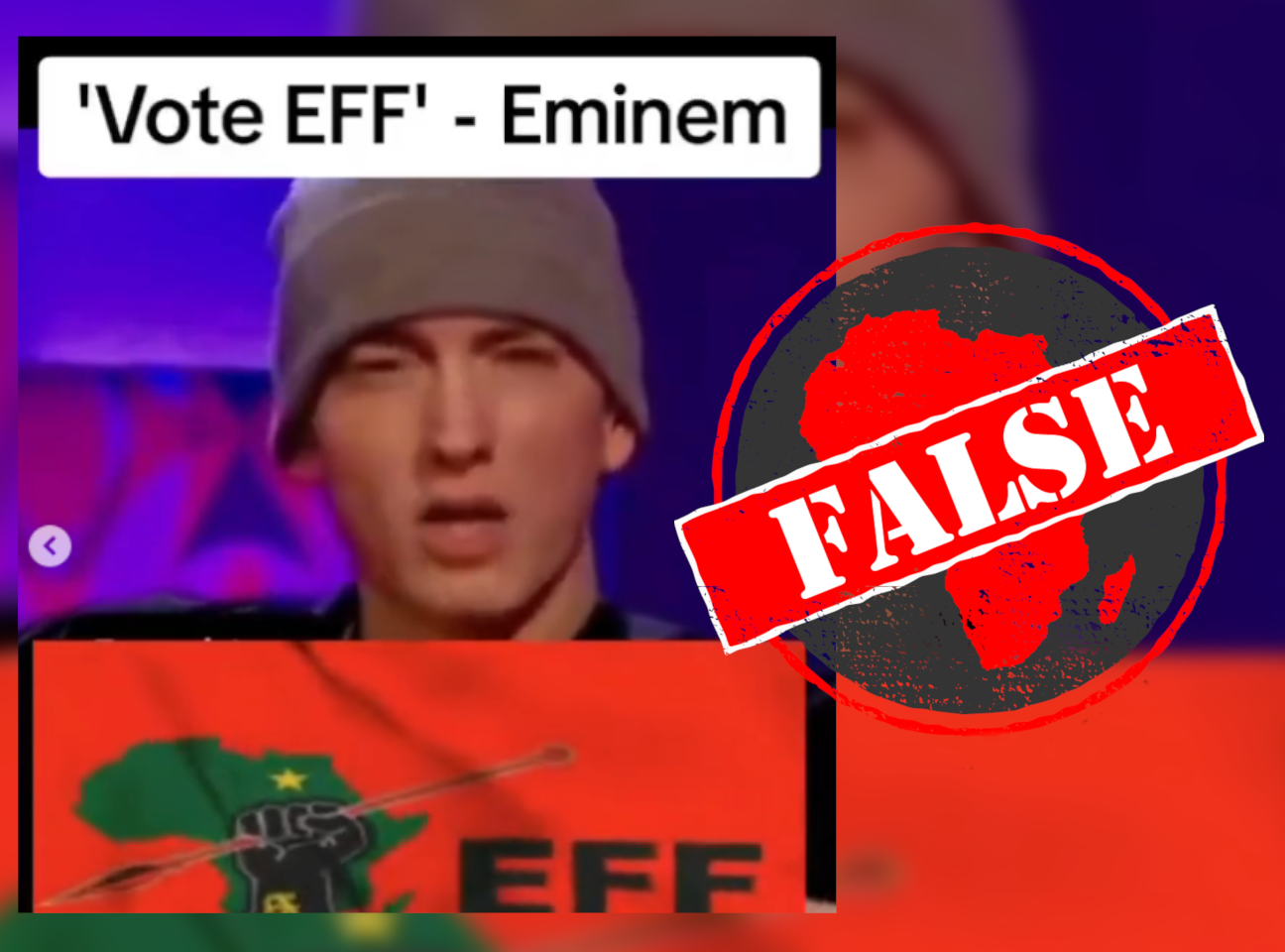IN SHORT: A video which has gained popularity on various social media platforms in early 2024 is a doctored version of a 2009 interview in which Eminem made no mention of South African politics.
A video circulating on social media appears to show US rapper Eminem implying support for South African opposition party the Economic Freedom Fighters (EFF) and discrediting the ruling African National Congress (ANC). This comes ahead of South Africa’s national elections in May 2024.
In the video, Marshall Mathers, better known by the stage name Eminem, says he spoke with EFF member Gail Sibiya, via Skype, and concluded that the ANC has “failed black folks in that country. No jobs, no roads, no water”. He goes on to rhyme: “Crime is high and you wonder why.”
The video has been circulating on Instagram, with 285,000 views here, as well as here and here. It appears on Tiktok here, with over 12,000 likes, here and here. It was also posted on X (formerly Twitter) here, with 173,000 views, as well as here, here and here. It’s on YouTube here, here and here.
But it’s a fake.

Forgery made from real interview footage
Africa Check performed a simple reverse image search on screenshots of the video clip, excluding the EFF party banner in the bottom half of the frame. You can try this yourself by following these steps.
This search returned various longer video clips featuring Eminem. Several versions of the interview segment are available on YouTube, all taken from a 2009 episode of British TV talk show Friday Night with Jonathan Ross.
Visually, these videos are almost identical to the EFF endorsement clip, except for the rapper’s mouth movements and voice. In both versions, he wears the same clothes and accessories, his facial expressions are partly the same, and sits before the same background. (See the screenshots below.)
As the talk show episode first aired over a decade ago, we can see that this is the original video, and that the audio and mouth movements have been altered in the newer version to change what the rapper says.
Deepfakes and how to spot them
This is known as a deepfake, where a form of artificial intelligence (AI) has been used to create content that impersonates someone. It uses some footage or content as a source, such as the talk show clip in this case. From this and possibly other footage, AI tools analyse the person’s voice and mouth or facial movements, and create a realistic new video in which the figure of the person is made to appear to say something they never did.
While this is the clearest indication that the Eminem video is a deepfake, there are other clues. If you watch the clip closely, the rapper’s face and mouth movements appear robotic and unnatural at times, a telltale sign of manipulation. The mouth movements are also not always in sync with the words being said.
There are also pieces of contextual information that signal that something might not be right. For example, internet searches show that in many recent videos and photos, Eminem appears visibly older than in this clip, suggesting that it was probably not filmed recently.
Asking the right questions
When you zoom out from the actual footage, there are questions that can be asked about the plausibility of the video. Does it make sense for the US superstar rapper Eminem, who has never been publicly involved with South African politics, to talk about a conversation with a relatively unknown member of an opposition party, and strongly express his opinion on who the country should vote for?
And if so, why would the video only appear on South African social media and not be picked up by legitimate news outlets, or the rapper’s own accounts?
On the flipside, what could anyone gain by making South African social media users believe that Eminem, one of the most influential rappers in history, had endorsed the EFF?
As deepfake technology improves, it’s becoming easier to create realistic impersonations of public figures without special skills or expensive tools. While there are still signs of manipulation in this content, these won’t always be visible with the naked eye, and other ways of detecting this kind of fakery will need to be developed.
But the public needs to know how not to be duped, now. Fortunately, traditional fact-checking skills still work, no matter how sophisticated an impersonation is. An internet search, both for screenshots and for the context of the story, can tell you a lot. So can asking who is – and who isn’t – posting the content, and why.
For more tips, see our guide to spotting AI-generated photos and videos.
Screenshot from Tiktok video
Screenshot from original 2009 clip
Republish our content for free
For publishers: what to do if your post is rated false
A fact-checker has rated your Facebook or Instagram post as “false”, “altered”, “partly false” or “missing context”. This could have serious consequences. What do you do?
Click on our guide for the steps you should follow.
Publishers guideAfrica Check teams up with Facebook
Africa Check is a partner in Meta's third-party fact-checking programme to help stop the spread of false information on social media.
The content we rate as “false” will be downgraded on Facebook and Instagram. This means fewer people will see it.
You can also help identify false information on Facebook. This guide explains how.


Add new comment